




Source: : https://4thworldmovement.org/wp-content/uploads/2018/03/poverty-myths-1-in-6.png
Poverty is known to be an individual who falls below the poverty line, becoming extremely poor. Poverty can be known to be temporary, but that isn’t the case for some Michiganders. Currently in Michigan, the 2020 poverty rate sits at 15.6 percent. It is estimated that one of six Michigan residents fall below the poverty line, any resident of Michigan falling below the poverty line can struggle to afford basic necessities. Our main goal is to raise awareness with regards to poverty by providing accurate information, statistics to support our evidence, and ways that you can help make a difference on how we can improve the lives of those who fall below the poverty line.
One main reason for poverty in the US is that there is a lack of good jobs and little job growth. According to the Economic Policy Institute, large groups of workers with full-time jobs are still well below the federal poverty guidelines.
Another main reason is a lot of people in the US don’t go to college and they lack a good education. Poverty is a huge problem and the only way to truly break the cycle is to go and get a good education. According to UNESCO, over 170 million people could be free from extreme poverty if they only had basic reading skills.
High costs are another reason why so many people are currently in poverty. Poverty is a lot different in every state because the cost of living is different all around. Food prices also differ from state to state and are unpredictable at times.
Medical expenses can also be a reason for poverty in the USA. Even with insurance a medical procedure can still cost thousands of dollars out of pocket. For someone who has little or no insurance this will send them to financial ruin. People who make less money are less likely to go to the doctor for this reason.
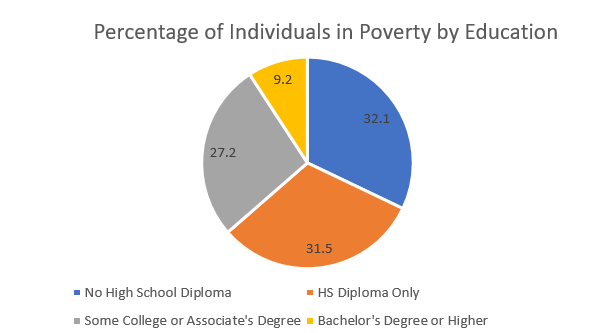
Source: http://cghudsongis515.wordpress.ncsu.edu/files/2017/12/project3_piechart_4.png
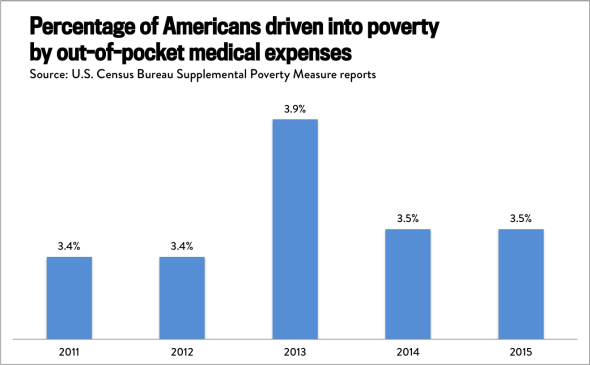
Source: https://compote.slate.com/images/c547b1de-44b0-406e-97e5-70b7f9f7eae1.png
Poverty can affect anyone, but some groups of people are more effected by poverty than others.
The poverty rate in Michigan is 15.6 percent. That means one out of every 6.4 residents in Michigan lives in poverty.
According to Welfare info, Females are more effected by poverty in Michigan with 16.7 percent living in poverty and 14.4% of males living in poverty.
According to Welfare info, African Americans are the most effected by poverty with 31.5 percent living in poverty, followed by, two or more races at 26.4 percent poverty, Next is Hispanic peoples with a poverty rate of 24.1 percent, then American Indians at 23.2 percent poverty rate, after that is Pacific Islander at 21.3 percent, followed by Asians at 14.3 percent and then Caucasian at 11.9 percent.
As we can see, race matters a lot in poverty rates because there is a very big difference between 31.5 percent of a race compared to only 11.9 percent. The Poverty rate for African Americans is 6.3 percent higher in Michigan than the national average.
Another interesting fact is that people born in the USA and are currently living in Michigan have a 15.4 percent poverty rate, compared to people born outside the USA who have a poverty rate of 18.6 percent in Michigan.
Age poverty stats:
Under 6 – 25%
6-11 – 21.8%
12-17 18.8%
18-59 15.8%
60-74 8.8%
75- 84 8.5%
85- up – 9.7%
One interesting fact about poverty in Michigan is that there is no middle ground between the cities that have high poverty rates and low rates. All the cities in Michigan either have less than 10 percent for poverty rate or above 20 percent in poverty rating.
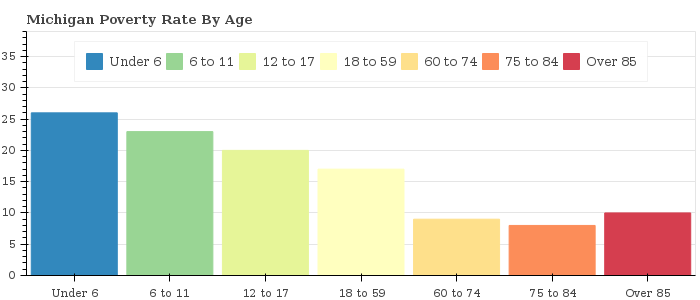
Source: https://www.welfareinfo.org/images/mi/michigan-poverty-rate-by-age.png
According to the U.S Census Bureau, in 2020, 8.8 percent of Michiganders were living in poverty. The previous census calculation, the annual poverty rate in Michigan was 9.7 percent.
Including the hardships of the COVID-19 pandemic, the number of Michigan residents living in poverty has managed to decline. Professor of social work at the University of Michigan, Kristin Seefeldt, stated that, “the pandemic stimulus checks and expanded unemployment benefits were some of the largest contributors to the recent reduction” among the poverty rates in Michigan. If it weren’t for the increased unemployment benefits and multiple stimulus checks, the poverty in Michigan was predicted to dramatically increase to 12.7 percent.
One in six residents of Michigan live in poverty. In 2020, 1.5 of 9.6 million Michigan residents fell below the poverty line. Michigan is currently ranked 36th in the nation with a poverty rate of 15.6 percent.
United Ways “ALICE Report” is the acronym for Asset, Limited, Income, Constrained, and Employed. The purpose of the ALICE Report is to assist families who earn more than the allowed federal poverty level, but don’t make enough to fulfill the basic needs of living. This includes the cost of food, housing, transportation, childcare, etc. Today in Michigan, the ALICE report shows that 43 percent or 4.3 million working Michigan residents struggle to afford everyday necessities.
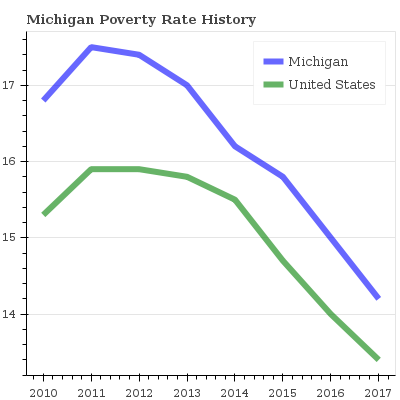
Source: https://www.welfareinfo.org/images/mi/michigan-poverty-rate-history.png
Throughout the years, Michigan has experienced poverty fluctuations like no other. Michigan has surpassed national poverty levels, several times.
The year 1983 for example, the median U.S poverty rate was 15.1 percent while Michigan had a residential poverty rate of 16.8 percent.
An article published by Mlive in January of 2019, thoroughly explains Flint Michigan’s transition from a “booming town” to one of the towns with the nation’s highest poverty rate. In the 1960s and 70s, Flint was known for housing the highest median income company, General Motors. Between the 1960s and 1970s, Flints poverty percentages hit an all-time low. In 2019, Flint held the nation’s highest poverty rate amongst the United States with at least 65,000 residents falling below the poverty line. The U.S Census Bureau estimated in 2016 that nearly 45 percent of Flint’s population didn’t meet basic living standards. Flint also holds the highest rate of childhood poverty with 58 percent of children under 18 years of age drastically falling below the poverty line. The national childhood poverty rate falls at an average 18 percent. General Motors, housed in Flint, was an employer that caused Flint to thrive, but also played a major role in the cities decline as jobs faded.
The New York Times, published an article in 2017, touching on the “Anatomy of Detroit’s Decline.” It was stated that “Detroit went from one of America’s most prosperous cities to one of its most distressed.” In the 1950s, Detroit was known as the fourth largest city in the country, as people moved to Detroit for employment with big auto industries such as, Ford, Chrysler, and General Motors. As these auto industries declined, so did the city of Detroit. By 2010, it was estimated that 36 percent of the city’s population fell below the poverty line. The city of Detroit also during this time has a vacancy rate of 27.8 percent. Poverty had forced most middle-class families to migrate to the suburbs to get a better education, have better employment opportunities, and escape the rising violence that fled the streets as poverty drastically increased.
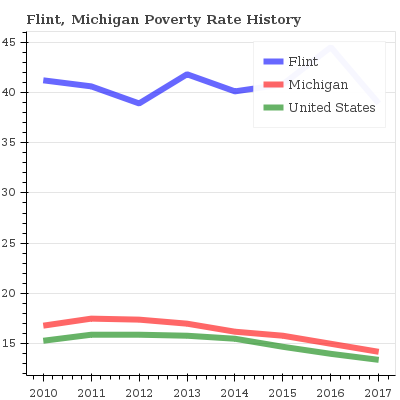 Source: https://www.welfareinfo.org/images/mi/flint/flint-michigan-poverty-rate-history.png
Source: https://www.welfareinfo.org/images/mi/flint/flint-michigan-poverty-rate-history.png
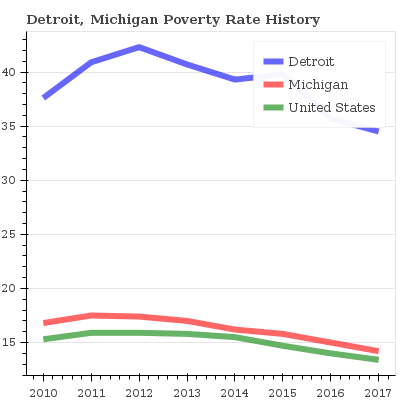 Source: https://www.welfareinfo.org/images/mi/detroit/detroit-michigan-poverty-rate-history.png
Source: https://www.welfareinfo.org/images/mi/detroit/detroit-michigan-poverty-rate-history.png
As there is no known solution to solving poverty, gathering together and providing services to those in need is the most effective solution there is to offer. We have provided a list of local homeless shelter organizations in Michigan that are always accepting volunteers.
Good Samaritan Rescue Mission: Bay City, MI
https://gsrmbaycity.org/how-to-help/volunteer-at-good-samaritan/
City Rescue Mission of Saginaw: Saginaw, MI
https://rescuesaginaw.org/how-to-help/volunteer-at-city-rescue-mission/
Midland’s Open Door: Midland, MI
https://www.midlandopendoor.org/get-involved/
Shelter of Flint: Flint, MI
https://shelterofflint.org/volunteer/
Detroit Rescue Mission Ministries: Detroit, MI
The Nehemiah Project: Petoskey, MI
Works Cited / Links to sources:
“10 Common Root Causes of Poverty.” Human Rights Careers, 11 May 2020, https://www.humanrightscareers.com/issues/root-causes-of-poverty/#:~:text=10%20Common%20Root%20Causes%20of%20Poverty%201%20Lack,Even%20the%20basics%20can%20be%20too%20expensive.%20.
“Anatomy of Detroit's Decline.” The New York Times, The New York Times, 8 Dec. 2013, https://archive.nytimes.com/www.nytimes.com/interactive/2013/08/17/us/detroit-decline.html.
BarbChicago, et al. “9 Top Reasons for Poverty in the United States.” Life And My Finances, 7 June 2020, https://lifeandmyfinances.com/2015/11/9-top-reasons-for-poverty-in-the-united-states/#:~:text=While%20one%20of%20the%20top%20reasons%20for%20poverty,of%20education%20has%20increased%20by%20almost%20double%20that%E2%80%A6.1%2C120%25.
Dominic Adams |. “Here's How Flint Went from Boom Town to Nation's Highest Poverty Rate.” Mlive, 21 Sept. 2017, https://www.mlive.com/news/flint/2017/09/heres_how_flint_went_from_boom.html.
Drawing Detroit. Drawing Detroit, 14 May 2012, http://www.drawingdetroit.com/changes-in-povertymichigan-and-metro-detroit/.
“Michigan Poverty Task Force.” Labor and Economic Opportunity - Michigan Poverty Task Force, https://www.michigan.gov/leo/0,5863,7-336-78421_97193---,00.html.
Michigan Radio | By Nisa Khan. “Share of Michiganders Living in Poverty Falls in 2020, Largely Due to Aid.” Michigan Radio, 21 Sept. 2021, https://www.michiganradio.org/economy/2021-09-21/share-of-michiganders-living-in-poverty-falls-in-2020-largely-due-to-aid.
“Poverty in Michigan.” Michigan Poverty Rate, https://www.welfareinfo.org/poverty-rate/michigan/#by-school.
